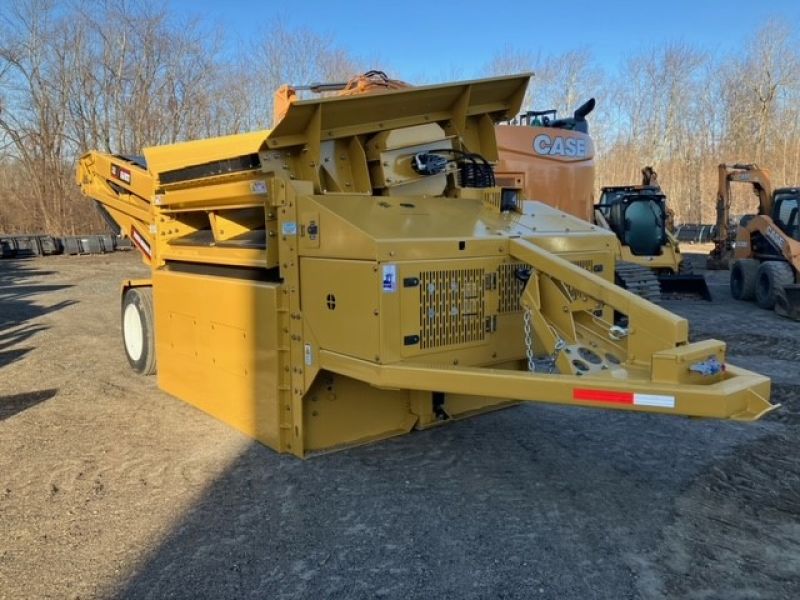Dirt screeners are essential tools in many industries, especially construction, landscaping, and agriculture. These machines help sift and separate debris, rocks, and other materials from soil, providing clean and refined dirt for various uses. However, buying a dirt screener can be costly, particularly if you only need it for a short-term project. Fortunately, dirt screenr rental offer a budget-friendly solution for individuals and businesses alike.
In this guide, we’ll cover essential tips for effectively operating a rented dirt screener. Whether you’re new to the equipment or a seasoned user, following these guidelines will help you achieve better results while ensuring the machine’s longevity.
What is a Dirt Screener?
A dirt screener is a machine designed to separate and filter materials based on size. It’s frequently used to sift out rocks, debris, and large chunks of dirt from finer soil, creating a more consistent material for landscaping, gardening, or construction projects. Dirt screeners come in various sizes and models, some of which are compact and suited for small-scale work, while others are heavy-duty machines designed for large operations.
If you’re considering using a dirt screener rental, it’s crucial to understand how to operate the machine correctly to maximize efficiency and reduce the risk of damage.
Benefits of Renting a Dirt Screener
Before diving into operating tips, let’s briefly discuss why opting for a dirt screener rental is a smart move for many projects.
1. Cost-Effective
Purchasing a dirt screener can be expensive, particularly if it’s only required for a one-time job or infrequent use. Renting allows you to access high-quality equipment without the hefty upfront cost.
2. Access to Updated Models
Renting offers the flexibility to use the latest models and technologies, providing you with the best possible performance. You can select a model tailored to the specific needs of your project without committing to a long-term investment.
3. Maintenance-Free
When you rent a dirt screener, the rental company is typically responsible for maintenance and repairs. This reduces the hassle of upkeep and ensures that the machine is in good working order when you receive it.
4. Flexibility
Depending on your project, you can rent a dirt screener for a day, a week, or even longer. This flexibility allows you to choose the most appropriate time frame for your project and only pay for what you use.
Operating Tips for a Rented Dirt Screener
Once you’ve secured your dirt screener rental, it’s essential to operate it properly to get the best results and ensure safety. Here are some tips to help you make the most of your rented machine.
1. Choose the Right Dirt Screener for Your Project
Not all dirt screeners are the same, so selecting the right one is key to getting the results you need. Consider the following factors:
- Size of Material: Are you dealing with large rocks or fine soil? Choose a screener with a mesh size that matches your project’s material.
- Volume: Ensure the screener you rent can handle the volume of dirt you need to process. Smaller screeners may be overwhelmed by large jobs, leading to inefficiency.
- Terrain: Consider the type of terrain you’re working on. If the ground is rough or uneven, you may need a machine that can handle those conditions effectively.
2. Conduct a Pre-Operation Check
Before you start operating the dirt screener, perform a thorough inspection to make sure everything is in good working condition. This will help prevent any surprises during use and ensure a smooth operation.
- Inspect for Damage: Look for any signs of wear and tear or damage that may have occurred before you received the machine. If you notice any issues, report them to the rental company.
- Fluid Levels: Check the fuel, oil, and hydraulic fluid levels (if applicable) to ensure they are at the correct levels before starting the machine.
- Safety Features: Make sure all safety guards, covers, and features are intact and functional. This includes emergency stop buttons and protective barriers.
3. Set Up on a Stable Surface
To operate the dirt screener effectively, place it on a flat, stable surface. Uneven ground can cause the machine to tip or vibrate excessively, leading to inefficient performance and potential safety hazards.
- Level the Ground: Make sure the surface where you set the screener is level. If working on uneven terrain, try to stabilize the machine using blocks or a firm foundation.
- Drainage Consideration: If you’re working in a muddy area, ensure that there’s proper drainage around the machine to prevent clogging or damage from wet materials.
4. Feed Material Steadily
One common mistake when using a dirt screener is overloading it. Feeding too much material at once can cause blockages and slow down the screening process.
- Feed at a Controlled Rate: Avoid dumping large piles of material into the screener all at once. Instead, feed it steadily and consistently.
- Avoid Overloading: Overloading the machine not only reduces efficiency but can also cause unnecessary wear and tear on the equipment.
5. Monitor and Clean the Screen Regularly
Over time, dirt and debris can clog the screener, reducing its efficiency. To prevent this, monitor the screen regularly and clean it as needed.
- Clean After Every Few Loads: Depending on the material you’re working with, it’s a good idea to clean the screen periodically to prevent blockages.
- Check for Damage: If you notice the screen is starting to wear out, replace it before it becomes a bigger issue. A damaged screen can lead to inconsistent results and machine damage.
6. Operate the Machine at the Right Speed
Each dirt screener has an optimal operating speed that ensures maximum efficiency without straining the machine.
- Follow Manufacturer Guidelines: Check the user manual or consult the rental company for the recommended speed. Operating the screener too fast or too slow can affect its performance.
- Adjust as Needed: If you’re dealing with coarser material or heavier loads, you may need to slow down the operation slightly to ensure effective screening.
7. Practice Safety First
Safety should always be a priority when operating any heavy machinery. Follow all safety guidelines provided by the dirt screener rental company to prevent accidents.
- Wear Protective Gear: Always wear personal protective equipment (PPE), such as gloves, safety goggles, and hearing protection.
- Keep Bystanders Away: Only trained personnel should operate the dirt screener. Ensure that no one else is near the machine while it’s in use to avoid accidents.
- Shut Off When Not in Use: When you’re finished using the machine or need to perform maintenance, turn it off completely to avoid injury.
8. Return the Screener in Good Condition
To avoid extra charges from the rental company, ensure the screener is cleaned and inspected before returning it.
- Clean Thoroughly: Remove any dirt, rocks, or debris from the screen and other parts of the machine.
- Report Issues: If any damage occurred during your rental period, inform the rental company right away. They may appreciate the honesty and provide repair solutions.
Conclusion
Renting a dirt screener is a cost-effective solution for projects that require soil or material separation. By following these operating tips, you can ensure that your dirt screener rental works efficiently, lasts longer, and performs safely. Whether you’re preparing a garden bed, constructing a foundation, or handling a large-scale landscaping job, using a dirt screener properly can save you time and deliver the clean, refined materials you need for success.
Remember, always conduct a pre-operation check, maintain the machine during use, and follow all safety guidelines to make the most of your rental experience.












